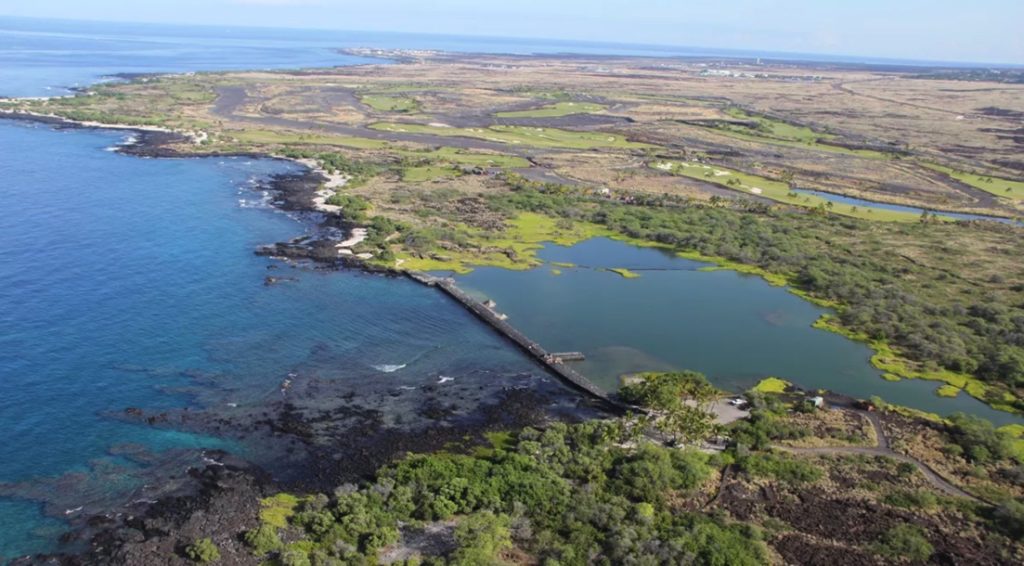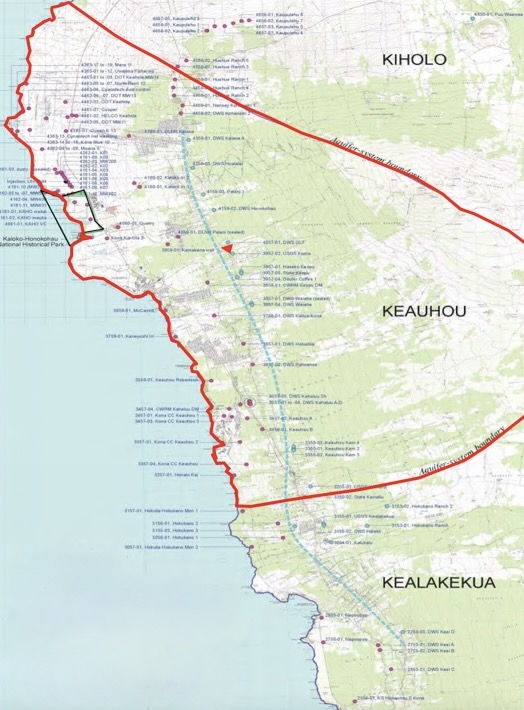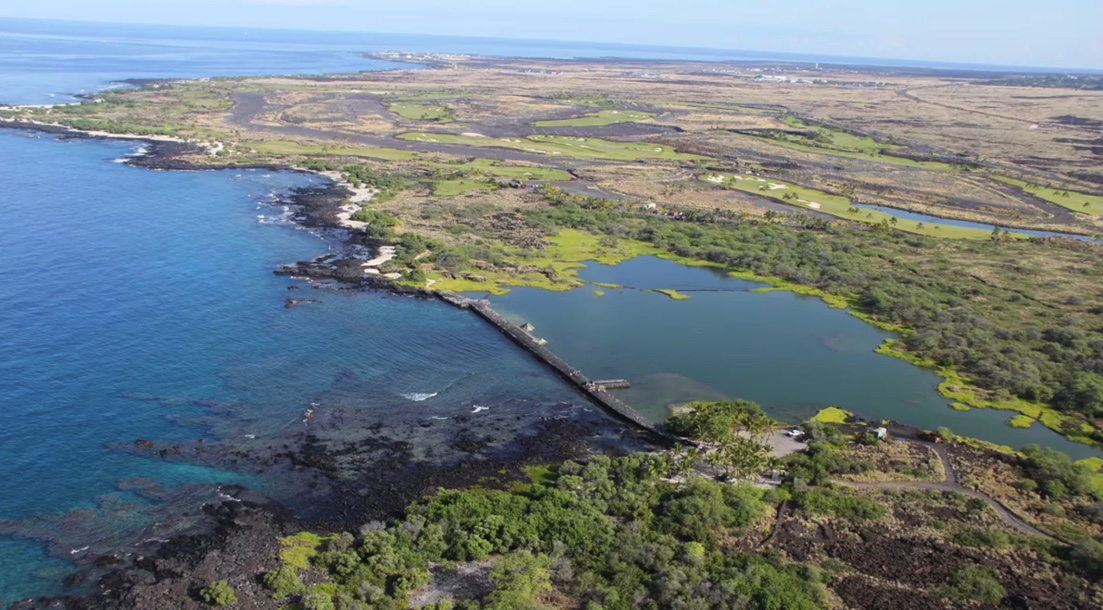On August 16, the Commission on Water Resource Management finally approved a permit for the construction of a well to serve the Natural Energy Laboratory of Hawaiʻi Authority (NELHA) in Keahole and the Hawaiʻi Housing Finance and Development Corporation’s (HHFDC) Kamakana Village affordable housing project.
NELHA had been working since 2015 to develop the Ota Well, as it’s called. The well is expected to cost between $15 and $20 million to construct and would have a pump capacity of about 1 million gallons a day, although NELHA and HHFDC have proposed to use just two-thirds of that — around 672,000 gallons a day.
Under a memorandum of understanding, the HHFDC and NELHA will share construction costs and the water produced by the well. If the well is successful, it will ultimately be incorporated into Hawaiʻi County’s Department of Water Supply system.
“This well will provide freshwater for HHFDC’s affordable housing projects, [the Department of Hawaiian Home Lands’] initiatives to support the native Hawaiian community and NELHA’s efforts to develop clean and quality green jobs at the Hawaiʻi Ocean and Science Technology Park for the residents of West Hawaiʻi,” wrote NELHA executive director Greg Barbour in testimony to the commission.
Although he was eager for the commission to approve a well construction permit, he was unhappy with several permit conditions recommended by commission staff to protect the groundwater supply and the traditional and customary native Hawaiian practices that rely on it.
After the commission unanimously approved the permit, with some amendments to those conditions, Barbour requested a contested case hearing. He was to have followed up with a written petition within 10 days, but asked for and received a 10-day extension from commission chair Suzanne Case. He now has until September 6 to file it.
Flashback
Water Commission staff had initially recommended approval of the permit in April of last year, but public testimony arguing that there had been insufficient analysis or consideration of the possible effects the well might have on the groundwater ecosystem resulted in the commission deferring a decision.
Ruth Loke Aloua and Kimberly Crawford Salina of the community group Hui Ola Ka Wai expressed their concerns that the additional groundwater withdrawals may impact the amount of freshwater flowing into the ocean – in particular, into the Kaloko fishpond that they look after.

Salina shared results from her water quality studies within the fishpond. “[T]here’s areas in the ki‘apua (the nursery pond), that should be able to sustain the life of the pua‘ama (mullet), ‘awa (milkfish), āholehole as well as the damselflies and other native plants and animals. While doing the tests, I consistently saw salinity above the threshold for those to thrive and survive. … That tells me we’re already at the danger level and need to make smart decisions moving forward so we don’t impact these environments anymore greatly than we already have,” she said.
Native Hawaiian Legal Corporation attorney Ashley Obrey, who represents the hui, told the commission that a decision on Ota Well sets the tone for future groundwater management in North Kona. Is the commission going to allow development that puts coastal resources and traditional and customary practices at risk or is it “willing to promote reasonable decision making in keeping with your kuleana over water management in Hawaʻi?” she asked.
“We are inclined to ask for a contested case but that unfortunately puts the burden on Loke, Kim and Hui Ola Ka Wai, which is in violation of Ka Paʻakai, so we would like to give the opportunity for the commission to deny this permit,” she said. Ka Pa’akai refers to a court decision that spells out how agencies are required to identify and mitigate impacts a proposed action may have on traditional and customary native Hawaiian practices.
The commission ultimately deferred voting on the permit so that a Ka Pa’akai analysis could be completed.
Originally, a symposium on mitigating impacts to traditional and customary practices in the area was going to be convened, but after consulting with lineal descendants of the area and representatives of the ʻAha Moku, commission staff instead held 20 hālāwai, which are “small intimate gatherings with individual ‘ohana and practitioners,” according to a staff report.
The hālāwai identified practices and resources connected to Kona’s groundwater, including “mauka and kula gathering and resources, coastal fishing and gathering, limu, fishponds, anchialine ponds, ulu niu and springs for drinking, bathing, and heiau rituals and ceremony,” it adds.
Conditions
On August 16, commission staff recommended approving the well construction permit with several conditions to mitigate the ecological impacts of the additional water withdrawal.
“[W]ells are withdrawing water from aquifers that are recharged by native forests that capture rain on the slopes of Hualālai. If there’s no investment or reciprocity, then that well development is purely extractive. Families expect water-neutral well development to mitigate impacts and ensure that there are sustainable resources into the future. More specifically, any proposed well development should directly contribute to watershed protection efforts and the collection/creation of water. For example, if a well is proposing to use 1 million gallons a day, then a contribution to watershed protection that will result in the protection of surface water and/or ground water quantity must be made to offset that extraction,” the staff report states.
Staff proposed a special permit condition that requires the well owner to pay $13,940 a year into the Water Resource Management Fund to assist the state Division of Forestry and Wildlife (DOFAW) with watershed protection. Staff arrived at that amount by dividing the well capacity (1 mgd) by the sustainable yield for the Keauhou aquifer (38 mgd), then multiplying the result by $525,500, which is the annual cost of water recharge-related activities in the Honuaʻula Forest Reserve Watershed Management Plan.
“If pump capacity increases or decreases, then the contribution will be adjusted accordingly based on the Watershed Management Cost-Share Formula. Management costs increase over time, so it is expected that the management contribution will be revisited every five years,” the special condition states.
Other required “mauka to makai mitigation measures” include real-time monitoring of rainfall and water levels at the well site; funding, designing, and implementing an annual inventory of resources along the shoreline and nearshore waters of Lanihau 1-2, Moeauoa ahupuaʻa; and holding annual community meetings to share updates on mitigation measures.
Also included in the special conditions were requests from the consulted cultural practitioners that the well water not be wasted, that it be reused as much as possible, and that the Kealakehe Wastewater Treatment Plant be upgraded to produce high-quality R-1 recycled water.
Other special permit conditions included providing water level data from various wells during pumping tests of the Ota Well, conducting a tracer/isotope study to assess changes in flow direction of high-level water and any connection between high-level and basal aquifer water near the well.
Finally, CWRM staff, ʻAha Moku, HHFDC, NELHA, DHHL, the National Park Service, and the county DWS must meet at least once a year to collaborate on mitigation measures recommended by the NPS, as well as the special conditions.
Objections
While Water Commissioner Mike Buck, a former director of DOFAW, praised the proposed fee for watershed protection, Barbour thought it needed some tweaking.
He argued that the groundwater recharge rate, which he said was 86 mgd, should be used in the fee calculation, not the aquifer’s sustainable yield. That would result in an annual fee of only $6,100. He also said he thought the fee should only apply for 20 years.
“We agree to the five-year reassessment [and] would like to see an audit of what the money is used for,” he told the commission.
He added that NELHA and HHFDC should not be solely responsible for doing the coastal resources surveys, which are “impacted by numerous mauka land uses, sea level rise, and stressors to the coastal ecosystem.”
“[W]e propose to contribute up to $5,000 annually for 20 years to the Department of Land and Natural Resources to fund a study beginning with the time that the Pump Installation Permit and Well Management certificate are issued,” he wrote.
“We really tried hard to do everything properly over the years. … I don’t think we tried to fast-track. We tried to be patient and ensure everybody’s concerns are addressed,” he concluded.
In written testimony, the Hawaiʻi County Department of Water Supply shared Barbour’s recommendations regarding the watershed management fee, adding that it wanted to know what statute or rule allows the commission to impose it.
“The implementation of this fee could potentially have impacts across Hawaiʻi island and the state of Hawaiʻi,” it stated.
The DWS also stated that it did not agree to funding or doing an annual inventory of coastal resources or collaborating on mitigation measures proposed by the National Park Service.
Water Commissioner Neil Hannahs told Barbour he was perplexed by the request to limit the watershed protection fee to 20 years. “What, in your data, … lets you assume it will be less important than it is now?” Hannahs asked.
Barbour replied that NELHA may be using a different water source decades from now and did not want to commit to a perpetual fee for a well it may not be using.
Dean Minakami, development branch chief for HHFDC, noted that the well has the potential to serve 2,000 homes in North Kona, but the watershed protection fees will be passed onto developers.
A First Step
ʻAha Moku representative Charles Young said the organization sees the mitigation measures as a step in the right direction and a way “to bring our people together to sort through issues in a holistic way.”
He and other members of the public thanked commission deputy director Kaleo Manuel for his work toward developing mitigation measures and the commission for calling for that work to be done.
The hui’s Aloua noted that there were a lot of things asked for by hālāwai participants that were left out of the recommended mitigation measures.
“This is really just a minimal first step. … I would hate for it to be modified or downsized because it’s inconvenient,” she said.
Obrey added that it was troubling to hear the permit applicants “try to nickel-and-dime the conditions,” and suggested that if the commission watered them down at all, she may want to ask for a contested case hearing.
With regard to the request in the special conditions that the Kealakehe Wastewater Treatment Plant be upgraded to produce R-1 water, it was made clear that task would fall solely on the county, not NELHA or HHFDC.
Bobby Command, representing Mayor Mitch Roth, testified that the county does plan to upgrade Kealakehe one day. “However, priority is a question. Our number one priority is to upgrade the Hilo Wastewater Treatment Plant.” Upgrading that facility will cost $175 million, he said.
“We’re aligned with all the goals. It’s matter of cost. … One of our goals is to get [agriculture] off of potable water,” he added.
Commissioner Buck echoed Obrey’s sentiments about the applicants’ reactions to the permit conditions.
“I’m really surprised the small amount of money … people are resisting,” he said of the watershed protection fee. He suggested that condition could be amended to clarify that the fee would only apply to an actively used well.
“And just a comment,” he added. “We keep hearing ‘What we typically do on these water permits …’ The word ‘typical’ just is not going to fly anymore in the future, especially for such a water stressed area. In Kona and all the deliberations we’ve had. I just really encourage all the water users to realize times have changed. Climate [change] is coming. The ability to spread the cost of maintaining the public trust, which includes tradition and customary native Hawaiian rights as well as the watershed protection, needs to be incorporated in your use of the water at all levels.”
Commissioner Hannahs pushed to add some teeth to the aspirational conditions encouraging more water reuse, but Case expressed her concern that the county will have the ultimate say in how and whether that occurs.
“Everyone is recognizing getting to R-1 is a priority. The Hilo situation sounds very important [but] I don’t want us, as a society, to be kicking the can down the road. … We gotta get there. We’re running out of water. We’re getting a drier society. We’re getting drought. We’re getting fires. We have population increases and this is not getting any better. We do need to move from somebody’s nice idea to reuse water to something … we’re all recognizing is a critical part of our overall water budget,” she said.
Hannahs said he agreed but noted that the county could commit zero dollars toward upgrading the Kealakehe plant under the proposed conditions.
Command said there was a possibility of working with HHFDC and maybe with the Water Commission on a memorandum of understanding to get where commissioners and members of the public wanted to go.
“We’re committed to doing it. Again it’s a matter of cost,” he said.
In the end, the commission approved the permit and the special conditions, with Buck’s proposed amendment and a few other small changes.
Hours after the vote, Barbour requested a contested case hearing. Young and Obrey expressed their interest in being parties to the case should one be granted.
— Teresa Dawson



Leave a Reply